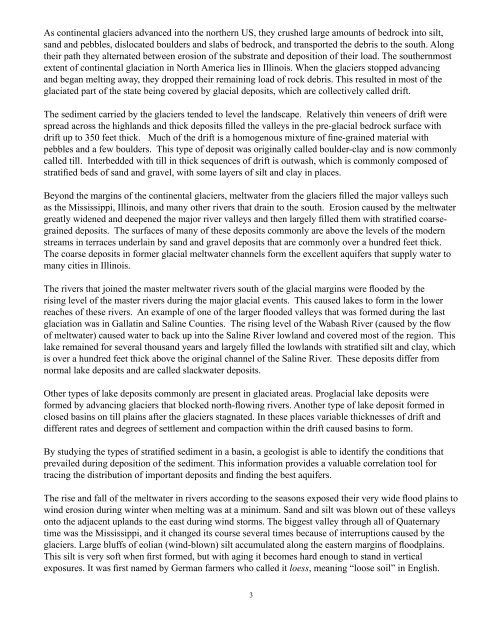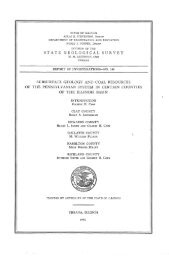This report presents basic d<strong>at</strong>a acquired from soil cores <strong>11</strong> <strong>through</strong> <strong>26</strong> <strong>of</strong> an anticip<strong>at</strong>ed 137 coring sitesfrom across the st<strong>at</strong>e. These cores were collected in southern <strong>Illinois</strong> during the fall <strong>of</strong> 1998. We currentlyhave limited descriptions, identific<strong>at</strong>ions <strong>of</strong> the geologic units and soil horizons, and results from a suite<strong>of</strong> chemical determin<strong>at</strong>ions from a selection <strong>of</strong> 5 to 6 samples per core. Mineralogical d<strong>at</strong>a are not yetavailable for the samples, but we have specul<strong>at</strong>ed in the “Results and Discussion” section <strong>of</strong> this reporton which minerals contain the various elements found in the soils. These specul<strong>at</strong>ions were based onavailable knowledge about the chemical compositions <strong>of</strong> the minerals th<strong>at</strong> are generally found in <strong>Illinois</strong>soils.There are several reasons to determine the chemical and mineralogical composition <strong>of</strong> soils: (1) to providea coherent geochemical d<strong>at</strong>abase <strong>by</strong> which to assess the health <strong>of</strong> the environment (including assessment<strong>of</strong> contamin<strong>at</strong>ion <strong>of</strong> soils) and in utilizing n<strong>at</strong>ural resources (Darnley et al., 1995); (2) “to evalu<strong>at</strong>e thecontribution <strong>of</strong> soil minerals to animal and plant ecology in the St<strong>at</strong>e” (Jones, 1986) or st<strong>at</strong>ed slightlydifferently, to determine the effects <strong>of</strong> soil composition (especially trace elements) on the health <strong>of</strong> plants,animals, and humans (Esser et al., 1991); (3) to rel<strong>at</strong>e the distributions <strong>of</strong> elemental concentr<strong>at</strong>ions in theSt<strong>at</strong>e to we<strong>at</strong>hering intensity and sorting <strong>of</strong> particles according to size <strong>by</strong> action <strong>of</strong> wind (Jones, 1986);(4) to show the associ<strong>at</strong>ion <strong>of</strong> trace elements with soil minerals (Esser et al., 1991); (5) to supplementinform<strong>at</strong>ion required to understand the geochemical landscape <strong>of</strong> <strong>Illinois</strong>; (6) to provide correl<strong>at</strong>iveinform<strong>at</strong>ion for understanding the composition <strong>of</strong> lake and river sediments; and (7) to provide a welldocumentedreference collection <strong>of</strong> cores for other inquiries.In a previous study conducted <strong>by</strong> the ISGS, 94 samples <strong>of</strong> soil were collected from 54 counties in <strong>Illinois</strong>(Zhang and Frost, 2002). Subsamples were retained from depths <strong>of</strong> 4 to 8 inches and 28 to 32 inchesbelow the surface. The samples were air-dried, disaggreg<strong>at</strong>ed, riffle-split, ground, and analyzed for major,minor, and trace element composition using the techniques <strong>of</strong> X-ray fluorescence spectrometry andinstrumental neutron activ<strong>at</strong>ion analysis. Most <strong>of</strong> the samples for Zhang and Frost’s (2002) study werecollected in northern <strong>Illinois</strong>, with minimal collection <strong>of</strong> samples from certain other parts <strong>of</strong> the st<strong>at</strong>e.The purpose <strong>of</strong> this present research project is to determine the chemical and mineralogical characteristics<strong>of</strong> soils and underlying unconsolid<strong>at</strong>ed m<strong>at</strong>erials <strong>through</strong>out <strong>Illinois</strong>, and to interpret the derived d<strong>at</strong>a inlight <strong>of</strong> the geological processes th<strong>at</strong> have acted upon the soils and their parent m<strong>at</strong>erials. In addition, thisproject will expand upon the previously collected d<strong>at</strong>a from other sources. A general d<strong>at</strong>abase <strong>of</strong> chemicaland mineralogical inform<strong>at</strong>ion will be cre<strong>at</strong>ed which can be used in assessing environmental conditionsand to help understand the effects <strong>of</strong> soils on plant health and productivity. The d<strong>at</strong>a collected willcontribute to our understanding <strong>of</strong> the chemical, mineralogical, and geological processes th<strong>at</strong> take placeduring soil development.BACKGROUNDThe present landscape <strong>of</strong> <strong>Illinois</strong> was cre<strong>at</strong>ed during the most recent part <strong>of</strong> geologic history known asthe Ice Age or the Qu<strong>at</strong>ernary Epoch (Willman and Frye, 1970; Killey, 1998). All <strong>of</strong> <strong>Illinois</strong> was affecteddirectly or indirectly <strong>by</strong> the continental glaciers th<strong>at</strong> advanced from the north on about six occasions overthe last million years (Follmer, 1996). Large-scale glaci<strong>at</strong>ion started earlier in Asia, but the glaciers didnot grow large enough in North America to advance into the US until about 800,000 years ago. Two <strong>of</strong> theolder glaci<strong>at</strong>ions in North America reached to the northern flanks <strong>of</strong> the Shawnee Hills in southern <strong>Illinois</strong>during the episode now known as the Illinoian (see Figure 1).2
As continental glaciers advanced into the northern US, they crushed large amounts <strong>of</strong> bedrock into silt,sand and pebbles, disloc<strong>at</strong>ed boulders and slabs <strong>of</strong> bedrock, and transported the debris to the south. Alongtheir p<strong>at</strong>h they altern<strong>at</strong>ed between erosion <strong>of</strong> the substr<strong>at</strong>e and deposition <strong>of</strong> their load. The southernmostextent <strong>of</strong> continental glaci<strong>at</strong>ion in North America lies in <strong>Illinois</strong>. When the glaciers stopped advancingand began melting away, they dropped their remaining load <strong>of</strong> rock debris. This resulted in most <strong>of</strong> theglaci<strong>at</strong>ed part <strong>of</strong> the st<strong>at</strong>e being covered <strong>by</strong> glacial deposits, which are collectively called drift.The sediment carried <strong>by</strong> the glaciers tended to level the landscape. Rel<strong>at</strong>ively thin veneers <strong>of</strong> drift werespread across the highlands and thick deposits filled the valleys in the pre-glacial bedrock surface withdrift up to 350 feet thick. Much <strong>of</strong> the drift is a homogenous mixture <strong>of</strong> fine-grained m<strong>at</strong>erial withpebbles and a few boulders. This type <strong>of</strong> deposit was originally called boulder-clay and is now commonlycalled till. Interbedded with till in thick sequences <strong>of</strong> drift is outwash, which is commonly composed <strong>of</strong>str<strong>at</strong>ified beds <strong>of</strong> sand and gravel, with some layers <strong>of</strong> silt and clay in places.Beyond the margins <strong>of</strong> the continental glaciers, meltw<strong>at</strong>er from the glaciers filled the major valleys suchas the Mississippi, <strong>Illinois</strong>, and many other rivers th<strong>at</strong> drain to the south. Erosion caused <strong>by</strong> the meltw<strong>at</strong>ergre<strong>at</strong>ly widened and deepened the major river valleys and then largely filled them with str<strong>at</strong>ified coarsegraineddeposits. The surfaces <strong>of</strong> many <strong>of</strong> these deposits commonly are above the levels <strong>of</strong> the modernstreams in terraces underlain <strong>by</strong> sand and gravel deposits th<strong>at</strong> are commonly over a hundred feet thick.The coarse deposits in former glacial meltw<strong>at</strong>er channels form the excellent aquifers th<strong>at</strong> supply w<strong>at</strong>er tomany cities in <strong>Illinois</strong>.The rivers th<strong>at</strong> joined the master meltw<strong>at</strong>er rivers south <strong>of</strong> the glacial margins were flooded <strong>by</strong> therising level <strong>of</strong> the master rivers during the major glacial events. This caused lakes to form in the lowerreaches <strong>of</strong> these rivers. An example <strong>of</strong> one <strong>of</strong> the larger flooded valleys th<strong>at</strong> was formed during the lastglaci<strong>at</strong>ion was in Gall<strong>at</strong>in and Saline Counties. The rising level <strong>of</strong> the Wabash River (caused <strong>by</strong> the flow<strong>of</strong> meltw<strong>at</strong>er) caused w<strong>at</strong>er to back up into the Saline River lowland and covered most <strong>of</strong> the region. Thislake remained for several thousand years and largely filled the lowlands with str<strong>at</strong>ified silt and clay, whichis over a hundred feet thick above the original channel <strong>of</strong> the Saline River. These deposits differ fromnormal lake deposits and are called slackw<strong>at</strong>er deposits.Other types <strong>of</strong> lake deposits commonly are present in glaci<strong>at</strong>ed areas. Proglacial lake deposits wereformed <strong>by</strong> advancing glaciers th<strong>at</strong> blocked north-flowing rivers. Another type <strong>of</strong> lake deposit formed inclosed basins on till plains after the glaciers stagn<strong>at</strong>ed. In these places variable thicknesses <strong>of</strong> drift anddifferent r<strong>at</strong>es and degrees <strong>of</strong> settlement and compaction within the drift caused basins to form.By studying the types <strong>of</strong> str<strong>at</strong>ified sediment in a basin, a geologist is able to identify the conditions th<strong>at</strong>prevailed during deposition <strong>of</strong> the sediment. This inform<strong>at</strong>ion provides a valuable correl<strong>at</strong>ion tool fortracing the distribution <strong>of</strong> important deposits and finding the best aquifers.The rise and fall <strong>of</strong> the meltw<strong>at</strong>er in rivers according to the seasons exposed their very wide flood plains towind erosion during winter when melting was <strong>at</strong> a minimum. Sand and silt was blown out <strong>of</strong> these valleysonto the adjacent uplands to the east during wind storms. The biggest valley <strong>through</strong> all <strong>of</strong> Qu<strong>at</strong>ernarytime was the Mississippi, and it changed its course several times because <strong>of</strong> interruptions caused <strong>by</strong> theglaciers. Large bluffs <strong>of</strong> eolian (wind-blown) silt accumul<strong>at</strong>ed along the eastern margins <strong>of</strong> floodplains.This silt is very s<strong>of</strong>t when first formed, but with aging it becomes hard enough to stand in verticalexposures. It was first named <strong>by</strong> German farmers who called it loess, meaning “loose soil” in English.3
- Page 1 and 2: A Progress Report on the Descriptio
- Page 3: INTRODUCTIONThe Illinois State Geol
- Page 7 and 8: In areas where the glacial sediment
- Page 9 and 10: the boundary between them. Where su
- Page 11 and 12: Occlusion refers to the physical en
- Page 13 and 14: tungsten carbide grinding capsule t
- Page 15 and 16: RESULTS AND DISCUSSIONSampling Plan
- Page 17 and 18: increases also. If the correlation
- Page 19 and 20: CO 2 gas= CO 2 aqCO 2 aq+ H 2O = H
- Page 21 and 22: Potassium Typically, potassium occu
- Page 23 and 24: on oxides and hydroxides. Fertilize
- Page 25 and 26: For most cores, the Rb content was
- Page 27 and 28: Brady, N. C. and R. R. Weil, 1999,
- Page 29 and 30: Killey, M. M., 1998, Illinois’ Ic
- Page 31 and 32: Table 1. Core number, county name,
- Page 33 and 34: Table 3. Texture of samples from co
- Page 35 and 36: Table 9. Texture of samples from co
- Page 37 and 38: Table 15. Texture of samples from c
- Page 39 and 40: Table 19. Soil texture, soil type,
- Page 41 and 42: Table 20 continued. Correlation coe
- Page 43 and 44: Table 21. Elemental composition of
- Page 45 and 46: Table 23. Elemental composition of
- Page 47 and 48: Table 25. Elemental composition of
- Page 49 and 50: Table 27. Elemental composition of
- Page 51 and 52: Table 29. Elemental composition of
- Page 53 and 54: Table 31. Elemental composition of
- Page 55 and 56:
Table 33. Elemental composition of
- Page 57 and 58:
Table 35. Elemental composition of
- Page 59 and 60:
Table 37. Means and ranges of eleme
- Page 61 and 62:
Sample locationFigure 2 Sample loca
- Page 63 and 64:
Figure 461
- Page 65 and 66:
Figure 6.63
- Page 67 and 68:
Figure 8.65
- Page 69 and 70:
Figure 10.67
- Page 71 and 72:
Figure 12.69
- Page 73 and 74:
Figure 14.71
- Page 75 and 76:
Figure 16.73
- Page 77 and 78:
Figure 18.75
- Page 79 and 80:
Figure 20.77
- Page 81 and 82:
Figure 22.79
- Page 83 and 84:
Figure 24.81
- Page 85 and 86:
Figure 26.83
- Page 87 and 88:
Figure 28.85
- Page 89 and 90:
Figure 31.87
- Page 91 and 92:
Figure 33.89
- Page 93 and 94:
Figure 35.91
- Page 95:
Figure 37.93
















